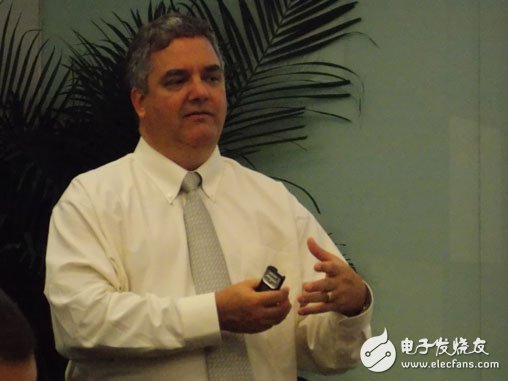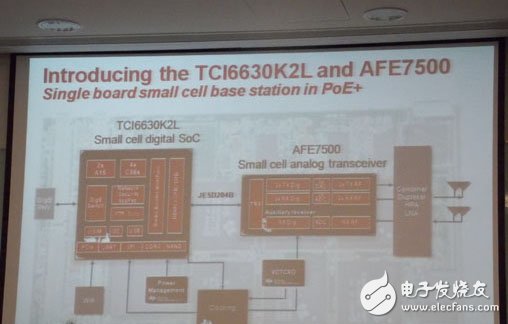Electronic enthusiasts News: Compared with the simple process advent of small base stations, deployment of small base stations can be described as extremely difficult. Small base stations are used to shunt, and the backhaul needs to solve the backhaul problem, such as what kind of backhaul method should be used; how to solve the power supply problem of the small base station; the installation and protection of the small base station; the continuous upgrade of the small base station, such as When upgrading from 3G to LTE, software and hardware upgrade issues and so on.
In view of this, Brian Glinsman, vice president of TI's processor business department, said that in order to actively respond to the latest challenges and needs of the industry, TI is striving to launch an important product deployment strategy based on KeyStone, and the latest TCI6630K2L system on chip (SoC) solution . TCI6630K2L can be combined with TI Base Station SoftwarePac and the latest analog front-end transceiver AFE7500 to achieve a huge breakthrough to solve the various challenges affecting the development of the small cell market without affecting performance characteristics, fully meeting the most stringent base station power consumption and cost demand.
In fact, although small base stations are small, the actual design requirements are not small at all. It needs to support dual mode (WCDMA + LTE or TD-SCDMA + TD-LTE), and also needs carrier aggregation function support. Carrier aggregation can combine the traffic of several frequency bands into large traffic for use. In this sense, TI's base station solution is the industry's first small base station solution.
Glinsman pointed out that in order to follow the trend, TI's small cell solution supports data flow aggregation. Small base stations require WIFI functionality. TI will provide back-end data flow aggregation and processing chips that provide sufficient processing power to support Wi-Fi carrier-grade functions.
In addition, the TCI6630K2L has unprecedented high DRFE integration, and the AFE7500 can achieve unparalleled high voltage efficiency and low cost goals. The dual-chip base station solution includes baseband chips, analog devices, and main design elements such as power supplies and clocks. Glinsman pointed out that the baseband is TI KeyStone's second-generation product. This chip is a complete single-chip base station solution, that is, an on-chip base station solution. The analog device completes all analog functions. The solution supports all 3G and 4G standards.

Brian Glinsman, vice president of TI ’s processor business, said TI ’s TCI6630K2L system-on-chip (SoC) solution is extremely competitive in size, cost, and performance.
With the increasing development of IC integration, whether Wi-Fi will be integrated into SoC will naturally become one of the main topics of concern in the industry. In this regard, Glinsman pointed out that in the face of the changing standards of Wi-Fi and the huge Wi-Fi shipments and the increasingly mature market, TI currently has no plans to integrate Wi-Fi modules into base station SoCs. Glinsman emphasized that Wi-Fi chip requirements will change according to different market requirements. If integrated into it, it will easily lead to restrictions on other applications. In view of this, the choice is now left to the equipment vendor to resolve.

TCI6630K2L achieves a major breakthrough in the small cell market by combining with TI Base Station SoftwarePac and the latest analog front-end transceiver AFE7500.
As the issuance of LTE licenses in China becomes clearer, the upgrade from 3G to 4G LTE will bring an unpredictable incremental market value. In order to meet the huge business opportunities of small base stations brought by the growing demand for mobile broadband communications, other than TI's pivotal position in this field, other chip makers are all scrambling to focus on this upcoming lucrative market.
It is understood that in April this year, the ASTRI in Hong Kong focused on introducing ASTRI ’s LTE small cell LTE small cell baseband core technology and LTE packet core evolution (EPC) and base station gateway solutions, attracting the attention of many players; March this year , Broadcom launched a highly integrated digital baseband processor and radio frequency transceiver single-chip system solution, and used 3G mobile network family-level small base station access point equipment; Freescale has already launched new wireless base stations as early as 2011 System on a chip (SoC) samples, these chips use QorIQ Qonverge series processors, pointing to picocell and Femtocell applications; driven by the ubiquitous connection demand and the high growth of cellular communications, Avago also intends to increase investment in small cellular base stations .
According to data from relevant analysis agencies, small base stations are expected to surge from 3.2 million in 2012 to 62.4 million in 2016, an increase of up to 2000% (or 20 times), accounting for 88% of the total number of global base stations.
It is worth noting that in the fierce market competition environment, TI has long-term leadership in the field of base station technology, coupled with analog expertise, can serve all users from customers to network operators to small cell manufacturers Provide a better wireless experience. It is foreseeable that due to the low power consumption demand, power management will play a pivotal role in the function of small base station products in the future. In the future, the integration of external functional devices in a single package, reducing external components is also a possible development direction. In addition, the key progress of small cell, including some important new acquisitions and the introduction of new products (combining small cell technology with Wi-Fi) are also worthy of attention.
——Executive Editor-in-Chief of Electronic Fever Network / Mo Yanfen
At the end of the 1940s, the first semiconductor triode was born in the world. With its characteristics of small size, light weight, power saving, and long life, it was quickly used by various countries and replaced electronic tubes in a large range. In the late 1950s, the first integrated circuit appeared in the world. It integrated many electronic components such as transistors on a silicon chip, making electronic products smaller. Integrated circuits have rapidly developed from small-scale integrated circuits to large-scale integrated circuits and ultra-large-scale integrated circuits, thereby enabling electronic products to develop in the direction of high efficiency, low consumption, high accuracy, high stability, and intelligence.
Digital Home Appliances Circuit Board
Appliances Printed Circuit Board,Automative Circuit Board,Digital Home Appliances Pcb,Digital Home Appliances Circuit Board
Chuangying Electronics Co.,Ltd , https://www.cwpcb.com
